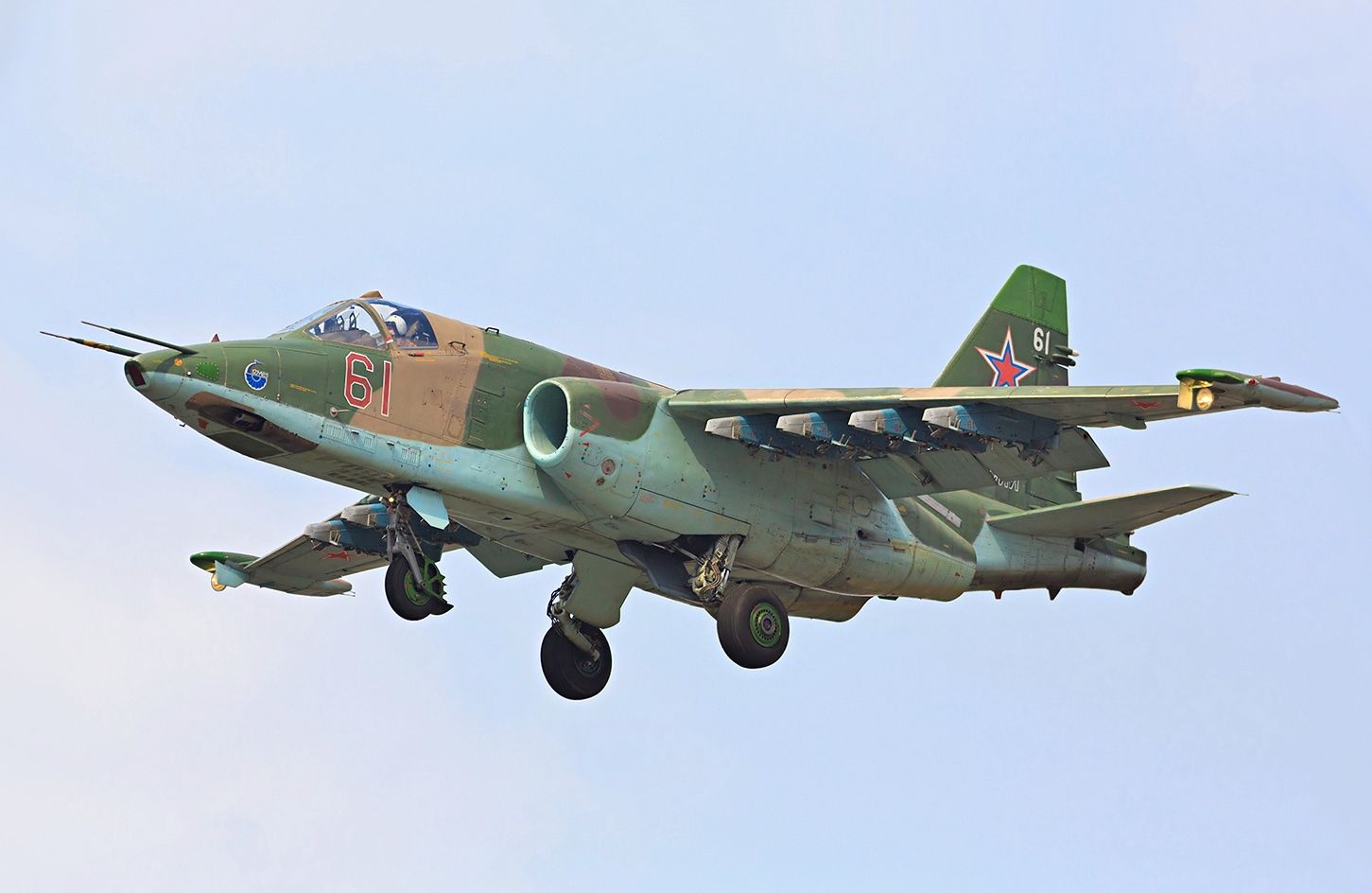Russia’s Rostec State Corporation plans to modify the Su-25 attack aircraft for new weapons based on what is believed to be a laudable combat performance in the ongoing Ukraine war.
20 Russian Warplanes Intercepted By F-16 Fighters Including Su-27 That ‘Downed’ MQ-9 Reaper Over Black Sea
Russia’s ‘Game Changing’ T-90 Tanks Disappoint In Ukraine War; Expert Decodes Why The MBTs Failed To ‘Change The Game’
The announcement was made by the first deputy general director of the state corporation, Vladimir Artyakov, who noted that the weapon upgrade on the combat aircraft would be based on the experience of Su-25’s deployment in Ukraine.
The Sukhoi Su-25 (NATO designation: Frogfoot) is a single-engine ground-attack aircraft primarily developed to execute ground attacks, close air support, and air interdiction tasks in direct support of ground troops during military operations.
Russia and Ukraine have extensively deployed a Soviet-era attack aircraft, the Su-25, in the ongoing conflict. It is incidentally the aircraft that suffered the most casualties in the war.
It mostly flies at low altitudes to strike targets on the ground, putting it within the range of enemy air defense systems and MANPADS.
“It is worth noting that the effectiveness of the latest modification of the Su-25SM3 has been increased significantly. The aircraft can use high-precision weapons, among other things. We will continue to improve this machine, taking into account the experience of using it in the NVO zone, including its refinement for new weapons,” Artyakov said.

The decision comes when the Su-25 is making headlines with Russia carrying out a massive missile and aerial assault on Ukraine. For instance, the Russian Defense Ministry (RuMoD) said in a statement that Russia’s Sukhoi Su-25 attack aircraft destroyed camouflaged Ukrainian positions and equipment.
A video was also released, which soon ignited discussions about this otherwise aging aircraft’s combat utility and capability. The RuMoD also noted that the Su-25 planes conducted airstrikes and released heat flares before returning to their base airfield.
?? According to this video released by the Russian Ministry of Defense, two Sukhoi Su-25 attack jets destroyed fortified field positions and armored vehicles of the Ukrainian army.
The Su-25 crews launched rocket air strikes, then performed a maneuver, releasing heat traps pic.twitter.com/DXPew7WcDu
— Sinnaig (@Sinnaig) May 7, 2023
Both Russia and Ukraine have lost several Su-25s in the ongoing conflict. Due to the threat posed by the enemy’s man-portable air defense systems (MANPADS), the Su-25 typically discharges its munitions while gently climbing for a longer range.
The weapon attack computer on the aircraft computes the range, height, and climb angle for precise delivery and gives launch cues to the pilot while accounting for weapon ballistics and prevailing winds. When the aircraft is near the target, it gently dives and launches the rockets into the target from a height.
The attack’s accuracy is higher when the range is low, but the pilot and machine are at higher risk. However, despite the dangers of flying the Frogfoot, it’s the most widely operated aircraft in the ongoing war.
Russia’s Su-25 Frogfoot In The Ongoing War
The utility of the Su-25 may have influenced the decision to carry out weapon upgrades on the aircraft. However, it was only in February 2023 that the RuMoD highlighted the capabilities of the upgraded Su-25 attack aircraft in a Telegram post titled ‘Upgraded Su-25SM3: Superpower Over The Battlefield’.
Over the months, multiple social media posts alluded to the deployment of the upgraded aircraft. Some reports in Russian media, including TASS, hinted that the highly modified Soviet-era aircraft was operational on the frontlines. However, RuMoD’s February announcement was considered the first official acknowledgment.
The latest announcement by Rostec’s first deputy general director Vladimir Artyakov confirms the aircraft’s widespread deployment and combat performance.
An upgraded Su-25, the Su-25SM3 is an armored subsonic attack aircraft designed to provide direct support for ground forces over the battlefield around-the-clock by attacking visible targets and destroying targets with specific coordinates around-the-clock in any weather.

The Su-25SM3 can carry 4.4 tons of payload and has a maximum speed of 975 kilometers. Its combat radius is 650 kilometers. This aircraft’s innovative SOLT-25 (optical, laser, and thermographic) target acquisition and navigation system sets it apart from earlier models.
The laser rangefinder-target designator, for one, facilitates the use of laser-homing “smart” ammunition. All these together allow the aircraft to locate targets automatically.
According to reports, the system enables unguided air-launched weapons to achieve guided weapons-level accuracy. Furthermore, it is three times more lethal than earlier upgrades and can destroy small ground and air targets around the clock.
The plane is armed with a 30mm GSh-30-2 dual-barrel autocannon from the Soviet era and various additional air-to-surface and unguided bombs and missiles.
Additionally, this sophisticated variant has an airborne self-defense system. Su-25SM3 aircraft could use their Vitebsk air defense to attack targets inside Ukraine without being detected because Ukrainian troops have widely dispersed portable air defense systems to shoot down low-flying ground assault aircraft.
Earlier this year, Russia’s local media outlets reported that the Russian Aerospace Forces (VKS) had tweaked their strategy and employed the Su-25 and Su-34 fighter jets in pairs during combat missions.
At the time, the military explained that such cooperation was essential during active electronic warfare because jamming can cause one of the aircraft’s navigation systems to malfunction. Furthermore, a fellow aircraft also comes to the aid of the attacking or ‘leading’ aircraft, covering them from above when the attacking aircraft has to fly at a very low altitude, rendering it vulnerable to MANPADS.
The Russian MoD stated at one point that the Su-25 was conducting successful attack missions under cover from the Su-30SM and the Su-35, the two workhorses of the VKS.
This adds to the combat utility and, as the Russian official said, the “indispensability” of the Su-25 Frogfoot.
- Contact the author at sakshi.tiwari9555 (at) gmail.com
- Follow EurAsian Times on Google News




